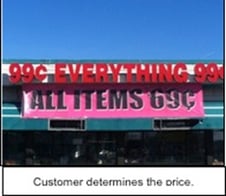Last week, a drive-by a 99 Cent Store (see photo) reminded me of my first real job in an industrial marketing department. In the 1970’s, one function of this department was to set prices, a task simplified in the early going by the market’s acceptance of whatever surcharges we added each year. In some years prices were increased twice! My job was to gather cost data on each product family, and multiply costs times our expected profit to determine a new price.

The basic formula was: Price = Cost + Profit
There were no reviews of costs – didn’t need to be. Nobody blinked when prices went up. In fact, each price increase created an opportunity for distributors to stock up just before the increase at a lower price: more sales for us, at least in the short term, and more profit for distributors. This was sales’ perpetual motion machine.
Sometime in the early ‘80’s the winds changed; customers in our market no longer accepted price increases. On the contrary, they began asking for price decreases. Our first instinct was to object. We were in denial for about five years thereafter, our salespeople forced to haggle with customers just to avoid an increase. In the process, we lost customers. A principle referred to by the creators of TPS as “cost subtraction“ had put the customer in the driver’s seat:
Profit = Price – Cost
The phrase “new normal” is used to describe a recent sea change in the world economy. “Cost subtraction” marked a less obvious sea change in the 1980’s, but one that arguably has contributed significantly to our latter day new normal. Simply put, the cost subtraction formula assumed that the customer determined the price and that profit therefore required effective cost management. Organizations that had previously been free to pass along cost increases, now had to find ways to reduce costs.
How did US industry respond? With outsourcing, off-shoring and leveraging of suppliers. We purchased larger lots from suppliers to avert their price increases, and then rewarded buyers for “cost avoidance”. We downsized our workforces and reduced employee benefits. A company president quipped, “we’ll charge employees for parking spaces if we have to.” Companies large enough to afford it sought to automate their way out of the dilemma, replacing employees with machines. These superficial improvements created paper savings while weakening productive strength and emptying cash reserves. Russ Scaffede, a former executive at General Motors, joked as a Shingo Conference speaker, “All our plants made money, only the corporation was losing its shirt.”
My little company did not have the financial resources to exercise many of these superficial options, which fortuitously led us to the discovery of TPS. We learned the story behind the cost subtraction principle: that the lion’s share of cost reduction could be found through many small improvements.
Forty years after the cost subtraction sea change, many organizations continue to deny it. Some are “lucky” companies, still able to price their products or services to cover wastes; others revert to superficial improvements to eke out a profit. Where does your company stand? Are you a lucky company? What are your cost subtraction strategies? Share a story with us.
O.L.D.

